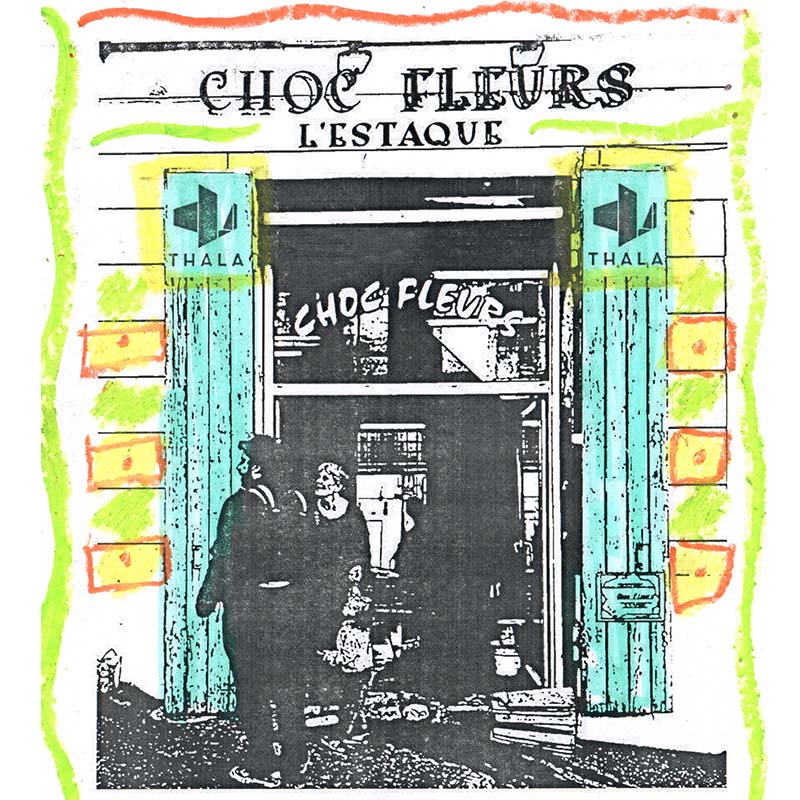



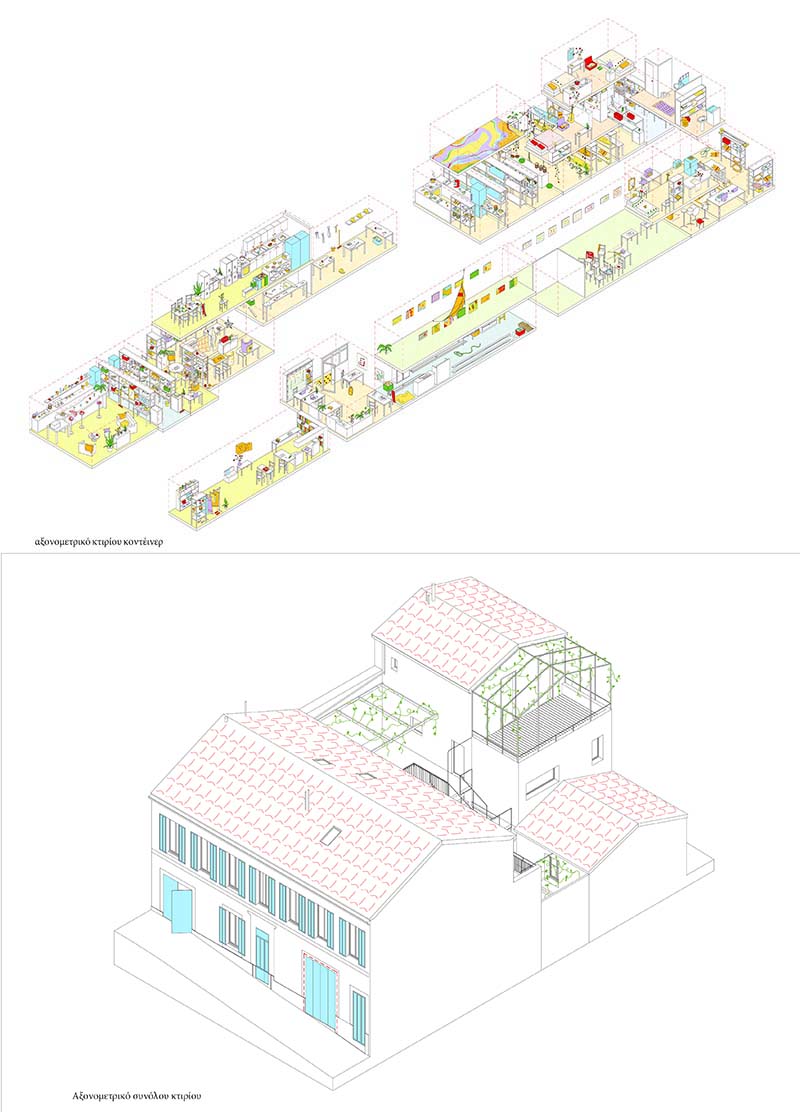

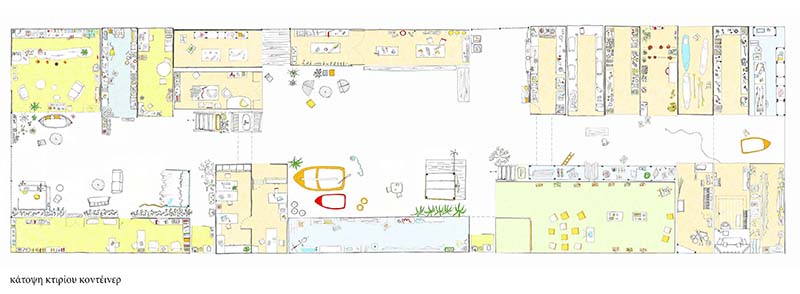





The project “Thalassanté: Methodologies of interweaving the commons” is based on an experimental research that focuses on the processes of creating commons. It takes as an example the work of Thalassanté, an association based in Marseille, and tries to understand how they arrive to collectively produce space. Space that is shared by the individuals who co-fabricate it and within which they develop practices of living together. Through this research focused on the material production of their processes, we seek also to demonstrate the ways in which individuals interweave with each other and create bonds of community. The methodology followed by the researcher consists of the active participation in practices with other people, their documentation, and at last their analysis.
This project calls us to reflect on the ways we choose to use architectural tools, by illustrating the potential impact of inclusion of more bodies in the processes. We wish to showcase the results produced by the collective ingenuity of the group and document in detail the methodology followed, to form a form of knowledge impulsively fabricated. And that in order to be able to share it with more individuals who wish to experiment with it. The aim is to create tools that can potentially facilitate the development of similar projects, symbiotic relationships and the appropriation of inactive spaces in the urban tissue.
This body of work hopes to present Thalassanté’s approach as an alternative example to the existing methods of space production, while as enriching dominant narratives and placing it in the realm of public sphere. All documents are produced within the framework of the integrated master degree’s project of Styliani-Ligeia Papaioannou, in the Department of Architecture of the University of Thessaly, under the supervision of professors Kotionis Zisis and Lykourioti Iris.
Supervisors: Kotionis Zissis, Lykourioti Iris
Reference Number: 1076
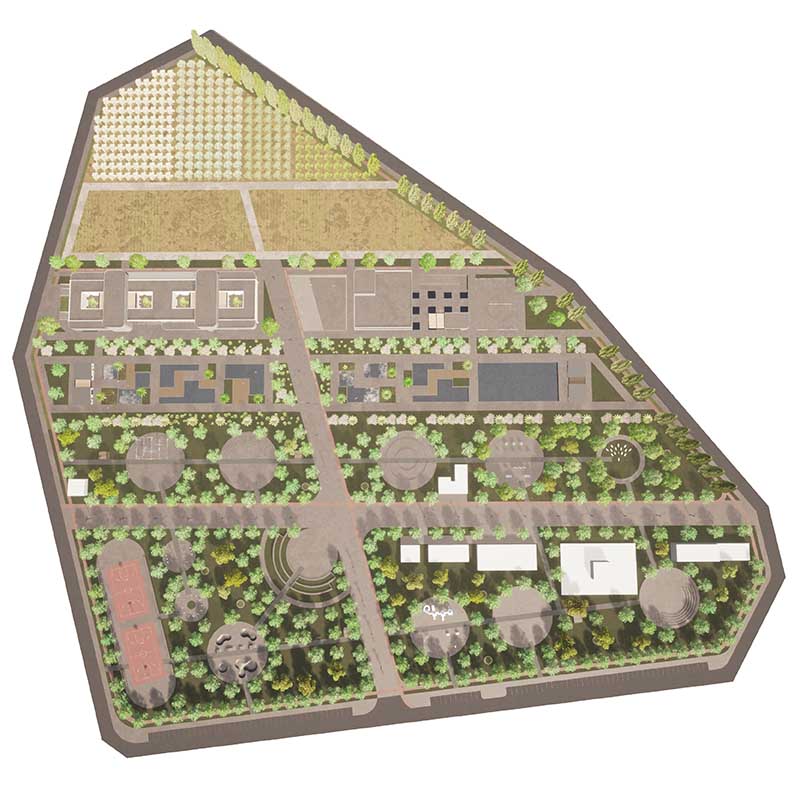

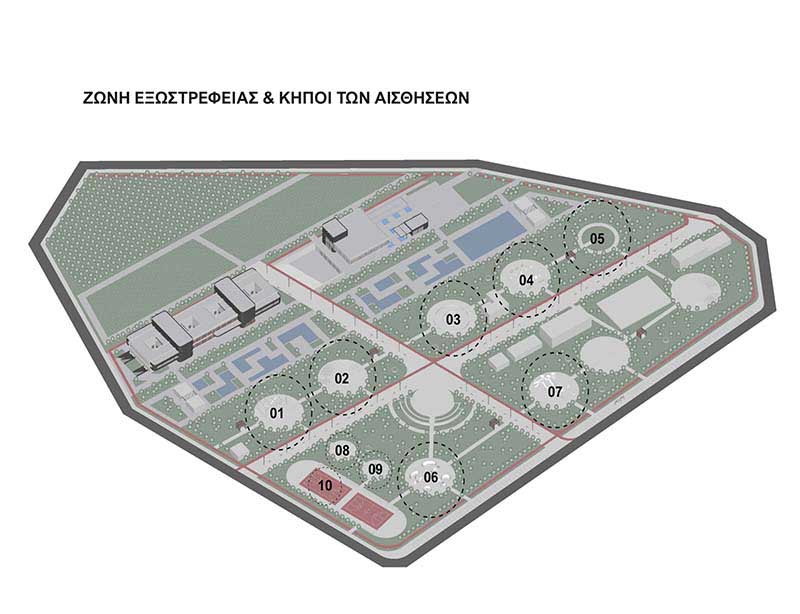

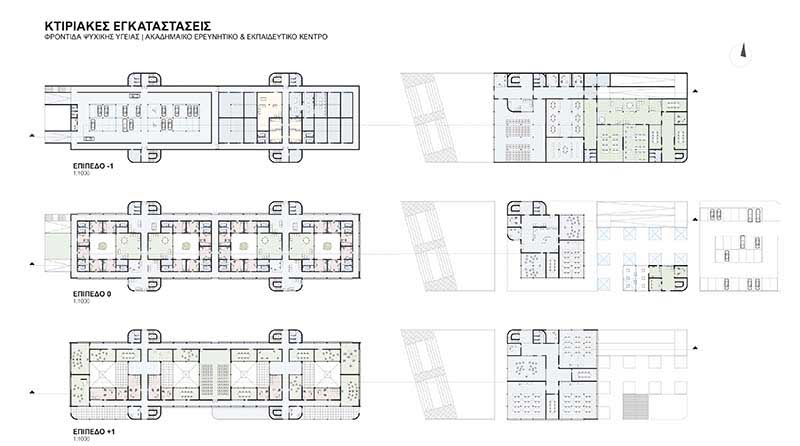



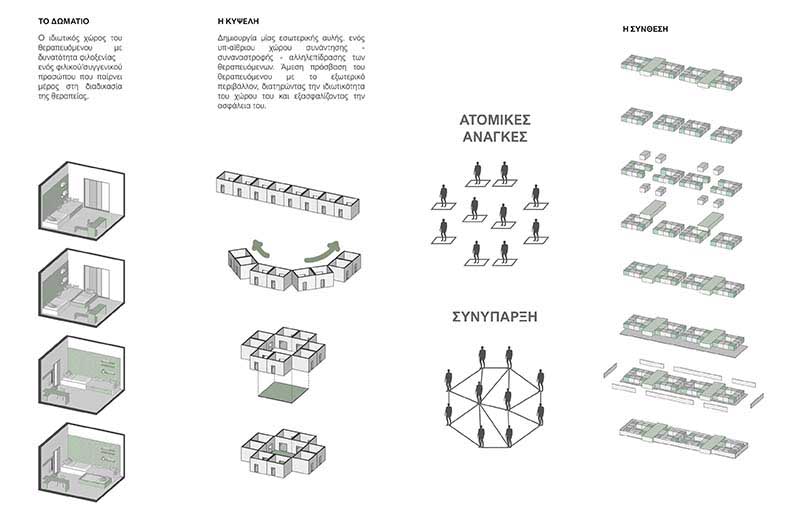

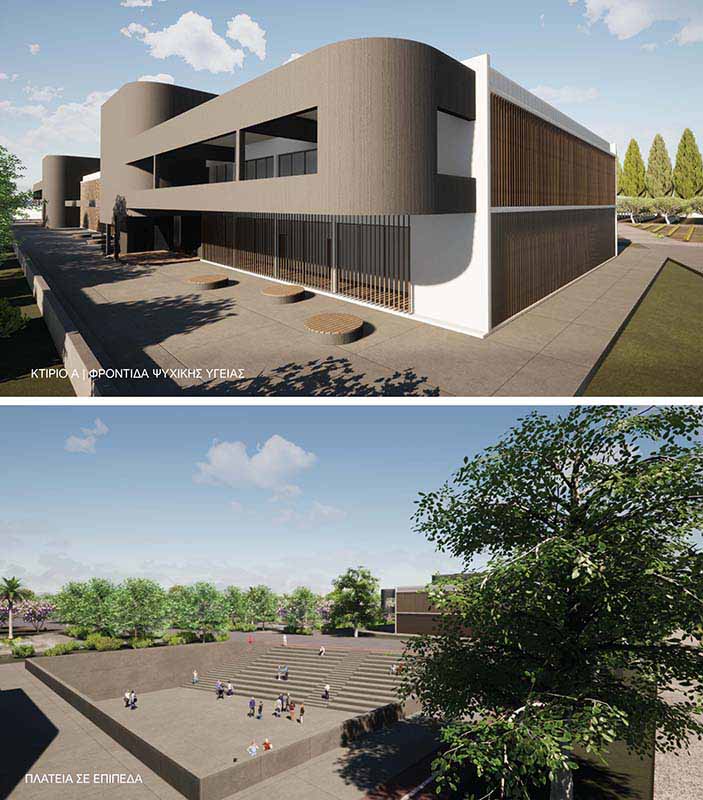

In urban environments, citizens face daily stressful everyday life and emotional challenges that can affect their mental well-being. Therapy is not always related to the complete restoration of the individual's clinical and mental health, but it is a process of gradual improvement of the quality of their life.
Through the analysis and the understanding of mental health, architecture and urban environment, I try to determine the role of architectural design in the recovery, not only of people living with mental health issues, but of all citizens who interact in urban environments. I studied the urban landscape through a political, social and environmental perspective, and through creative design, I present it as a therapeutic environment.
The former military camp Ziaka, is located in Thessaloniki, and it was chosen as the field for this design study. The studied area is a large land area of 124 acres, with limited existing structures in it. Upgrading this underutilized area with a strong social significance through an architectural-urban-political planning, creates an important background for the overall upgrading of the area.
Through the effort to reconcile the diverse requirements of a study to achieve a comprehensive synthetic identity, the design path elaborates a series of strategic interventions on multiple scales, ranging from general spatial planning to detailed building design and the planning of their interior spaces and functions.
Private therapy spaces place the individual-unit at the center of therapy, focusing on their personal needs. Through their gradual personal healing process, individuals reflect, evolve and in a second phase, engage with the community, participate and interact.
Through the design of public urban space, agricultural areas, green spaces, hydrotherapy areas, sports and cultural facilities, the aim is to stimulate all the senses of the citizens. Not only the treated guests but also the visitors - residents of the surrounding degraded urban life. The park welcomes the visitors, guiding them through the stages of therapy and rehabilitation, and finally reintegrating them, slightly healthier, back into the city and their daily routine.
Supervisor: Stylidis Iordanis
Reference Number: 1057


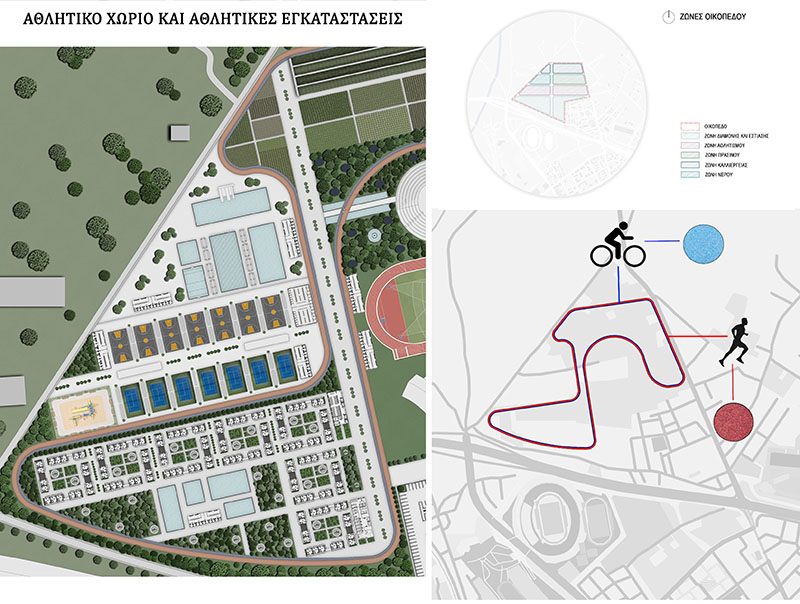

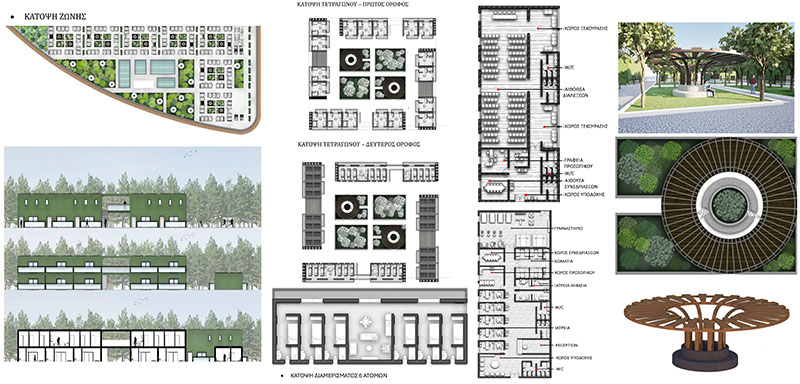

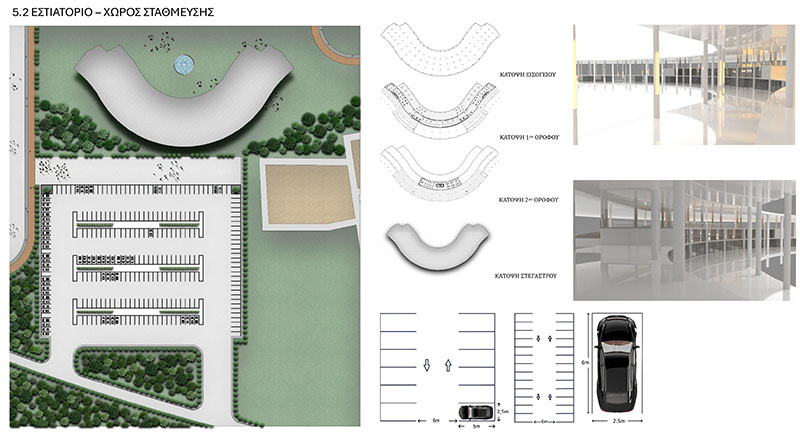





A large-scale sports village has been designed in Nea Ionia, Volos, which aspires to become a hub of hospitality, exercise and sporting events for sports teams, athletes and local residents. The village, located on the north side of the ring road, is set in a lush environment with groves, gardens and food crops, offering an ideal combination of nature and sport.
Facilities include football, basketball, tennis and athletics pitches, as well as a playground for younger visitors. In addition, there are water reservoirs for water activities and hospitality facilities for athletes and visitors, making the village a destination for sports, education and recreation. The aim is to provide a holistic experience that not only promotes physical activity but enhances healthy lifestyles and well-being through direct contact with nature.
The sports village is designed to provide access and activities for people of all ages and backgrounds, encouraging participation in sporting and recreational events. Particular emphasis was placed on accessibility, safety and sustainability of the facilities. Also included within the plot are accommodation for sports teams, educational centers and a small hospital to meet medical needs, ensuring the care and safety of visitors.
This sports village aspires to be a multifunctional center that will enhance sports activity in the area and provide a recreational and health space for the local community. By combining sport, nature and social coexistence, it contributes to the creation of an active and healthy community, while enhancing the economic and cultural development of the area.
Supervisor: Stylidis Iordanis
Reference Number: 1093


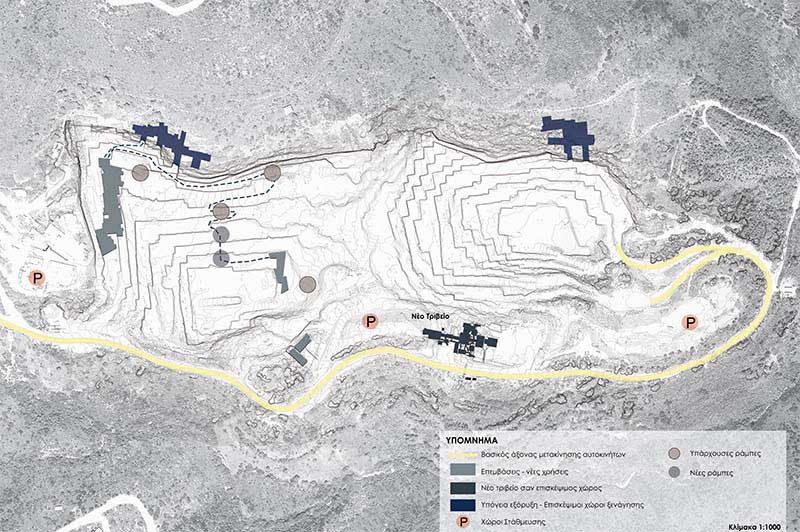

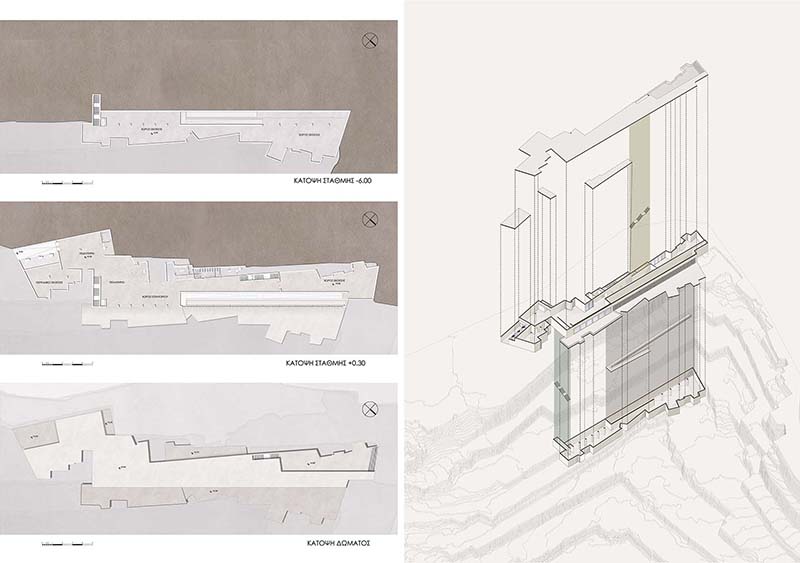



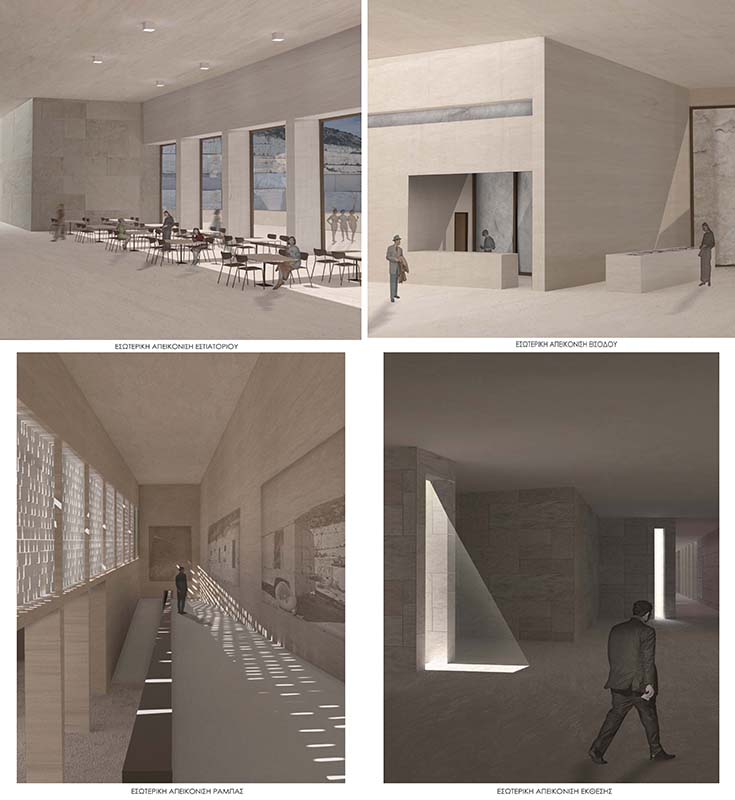

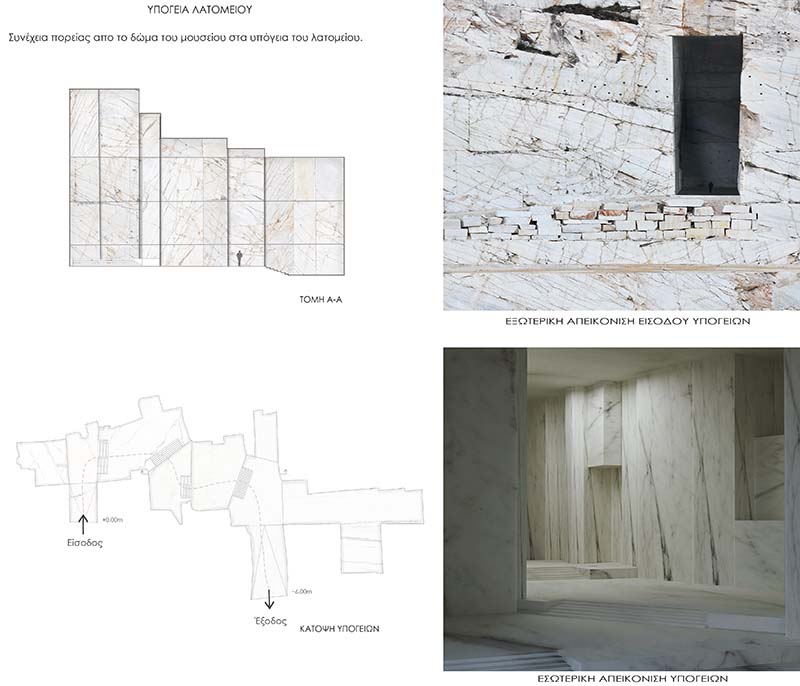

Mount Pentelicus rises to the northeast of Athens and consists of a single ridge stretching from west to east. The presence of white marble within the mountain led to the establishment of ancient and modern quarries. The natural relief of the mountain has been eroded and transformed over time due to continuous extraction of white stone. Observing the relief of Pentelicus served as the starting point for this thesis.
The Dionysus quarry, on the northern side of the mountain, was chosen as the intervention point, being the only operational marble quarry in Pentelicus to date. The violent intrusion of the white quarry landscape into the natural space is evident from a distance, reflecting the impact of modern quarrying processes. The method of surface mining, gradually removing soil for mineral exploitation, creates marble-faced terraces, altering the topography of the area. At the Dionysus quarry, the marble faces, colossal gates to the underground extraction, and additional industrial installations, compose the newly constructed landscape, where marble serves as a vital element in various qualities and sizes.
This thesis aims to reassess the mining landscape through a hypothetical scenario of quarry abandonment. The residual landscape is utilized as the core of analysis and design. Proposed interventions leverage the space's characteristics, placing visitors inside the quarry and creating new uses. Movement within the space, human scale, views, and the materiality of marble define the new framework for understanding the space.
Today's restoration primarily focuses on covering and leveling the excavation voids in combination with vegetation restoration. In contrast, this thesis treats the residual quarry relief as a dynamic space containing a set of relationships and interactions related to the violent quarrying process. Seeking new ways to revitalize the residual landscape beyond restoration limits, as well as reconnecting it to the urban fabric, delineate the design framework of this work.
Supervisor: Manolidis Kostas
Reference Number: 1044
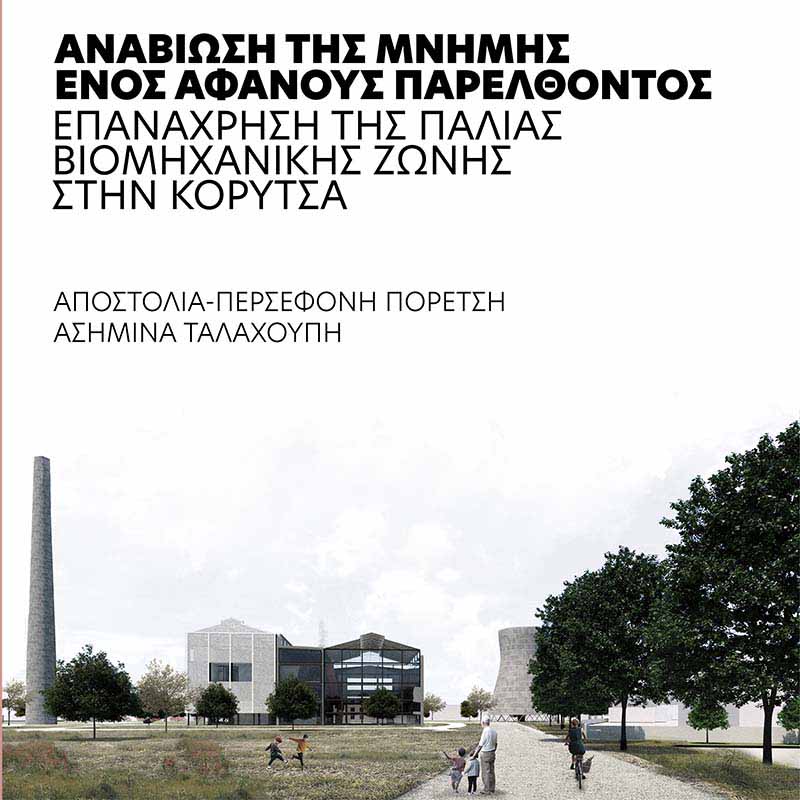

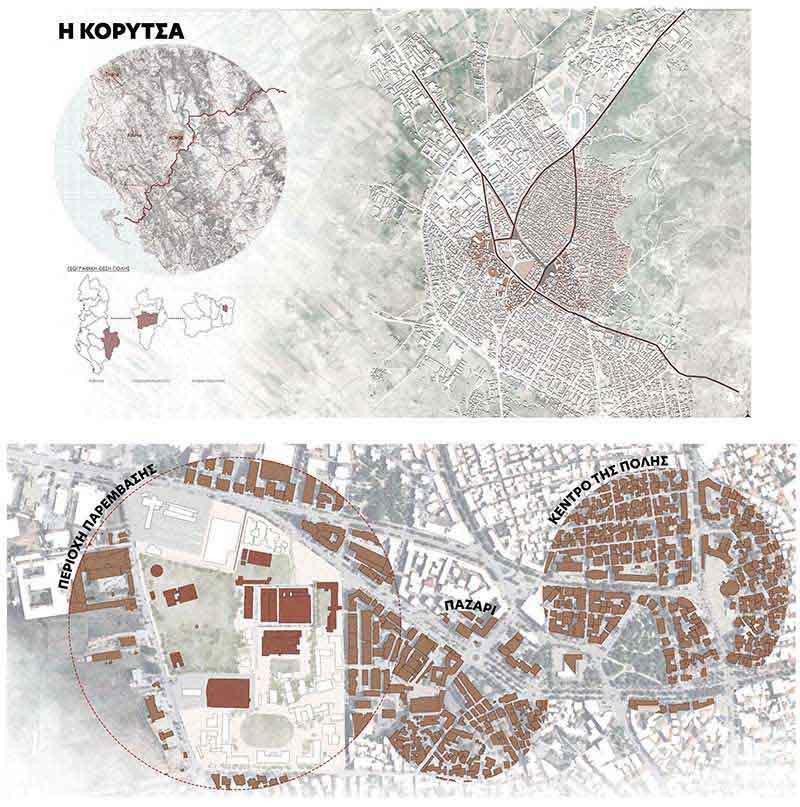

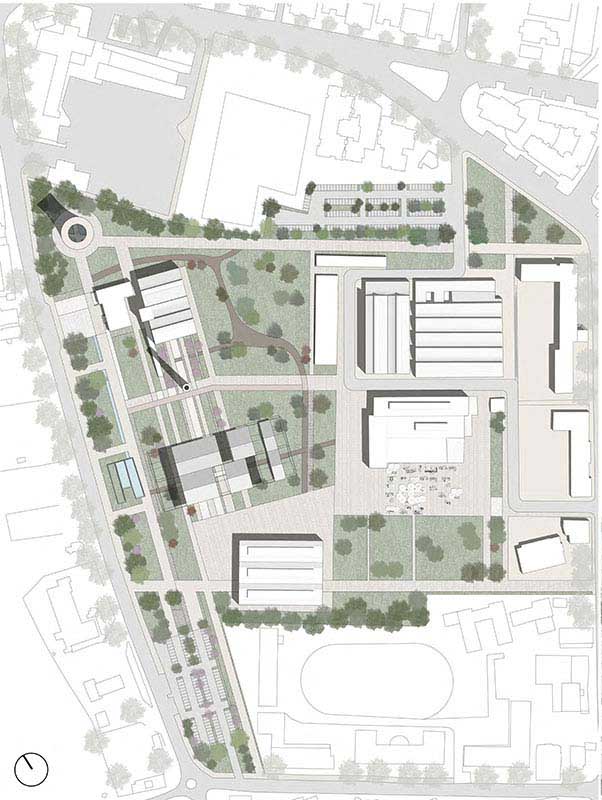

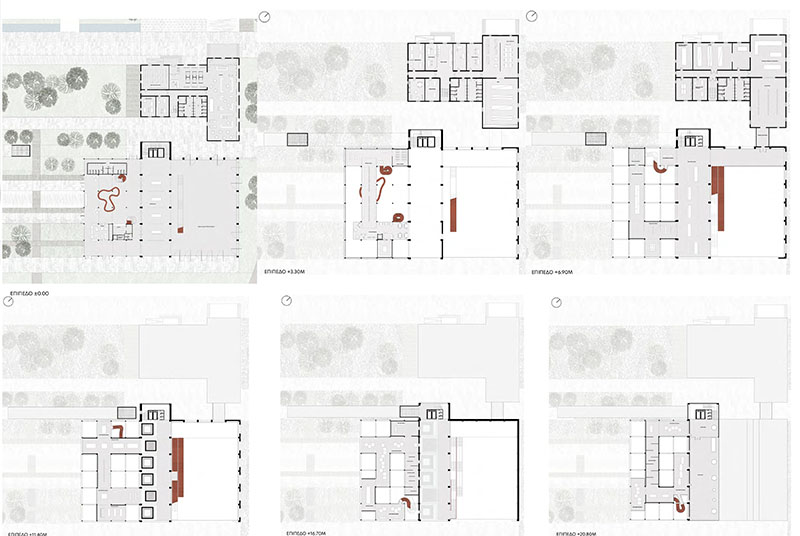

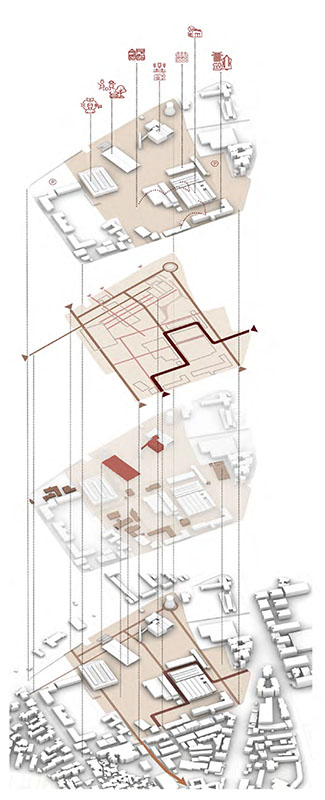

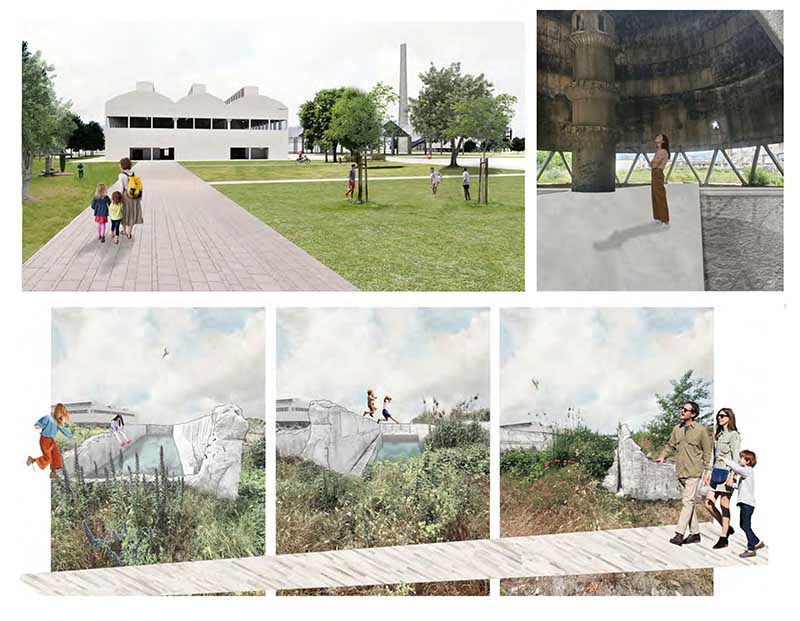

Post-1991, Albania's transition from socialism to a market-oriented economy had a profound impact on its urban and industrial landscape. In the framework of this context, this project focuses on Korçë's evolution, analyzing the city’s spatial dynamics and proposing strategic interventions for redeveloping its old industrial zone. By emphasizing the importance of preserving the industrial heritage while adapting to contemporary needs, the study investigates the spatial relationship between industry and urban development. The project advocates for the adaptive reuse of these structures, recognizing at the same time their historical and cultural significance. The proposed interventions aim to rejuvenate the old industrial zone, visualizing it as a vibrant community space. While briefly exploring Korçë's historical significance, the project predominantly accentuates strategic design elements. It proposes a comprehensive strategy for intervention which prioritizes accessibility and functionality. Namely, key features of the design include pedestrian-friendly pathways, efficient parking facilities as well as the integration of green spaces. The establishment of a dynamic community hub, through the repurposing of existing buildings and the introduction of innovative architectural elements, constitutes a principal feature of the current project. The incorporation of glass and metal structures adds a modern touch whilst preserving the industrial character of the site. Moreover, the project proposes the creation of a museum within the renovated industrial zone, dedicated to showcasing Korçë's industrial heritage. This museum will operate as a focal point for visitors, offering insights into the city's industrial past. Via interactive exhibits and curated displays, the museum aims to educate and engage visitors of all ages, contributing to the cultural enrichment of the community. In conclusion, the project advocates for the transformation of Korçë's old industrial zone into a multifunctional space that celebrates its industrial heritage. By employing strategic design interventions and the establishment of a dedicated museum, the objective is to create a sustainable and inclusive environment that meets the diverse needs of the community.
Supervisor: Micocci Fabiano
Reference Number: 1040
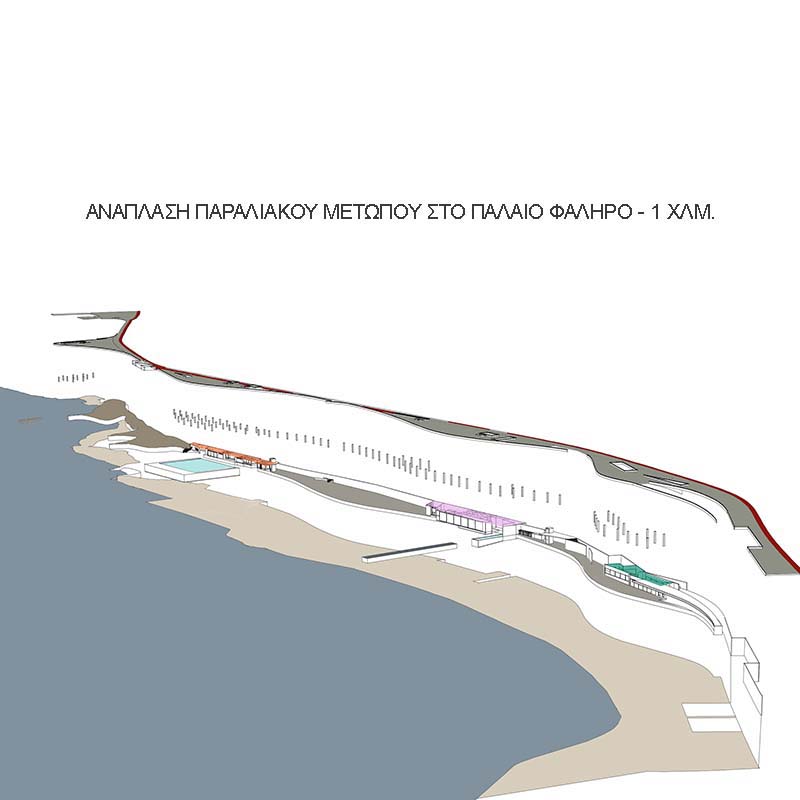

Given the rapid pace of everyday life and the alienation of man from nature, this thesis focuses on creating a new design that aligns with new living conditions. The project revolves around the redevelopment of the coastal area of Paleo Faliro (1km), in order to eliminate the height differences and to provide direct access to the beach for residents and visitors, effectively eliminating the boundary between the city and nature. The main axis of the redevelopment is the water. The building structures will be based on this core axis as well as on the forms they can take and the surfaces they can cover. This design will address both the pedestrian walkway and the beach level. In a pragmatic assessment and with the analysis and mapping of the current situation, certain existing uses are retained while undergoing adjustments. Particular attention will be given on the treatment of the boundary through a combination of enclosed and open spaces and the creation of atriums, that will facilitate gradual transitions from private to public areas. Three building complexes are proposed at the beach level, designed in a way that the water will seep into them while parts of these buildings will extend into the water with lightweight structures, such as platforms. Furthermore, the pedestrian walkway will be widened in certain places, creating the concept of a “plaza”, a gathering square. The project will feature programmes such as wellness, rehabilitation and water-based recovery areas. It will also include recreational and activity zones for relaxation as well as all essential building facilities to ensure the proposal functions effectively as a cohesive whole.
Supervisor: Paniyiris Costis
Reference Number: 1090


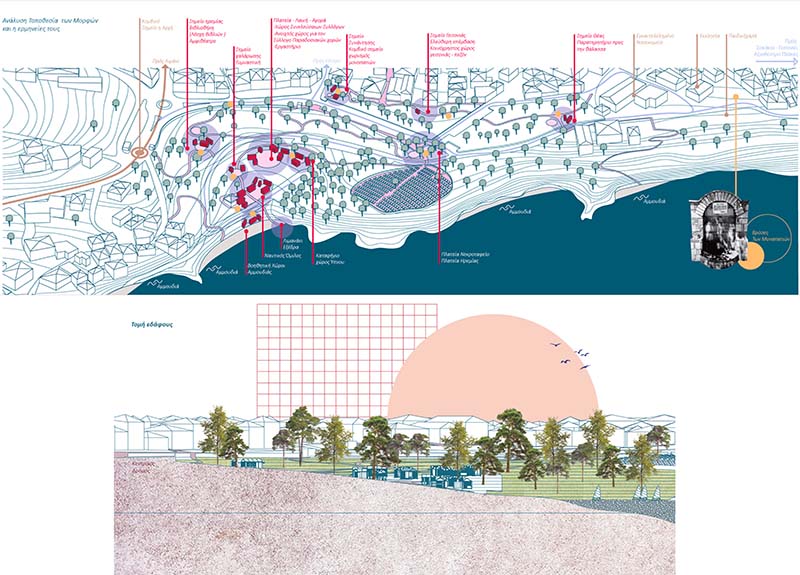

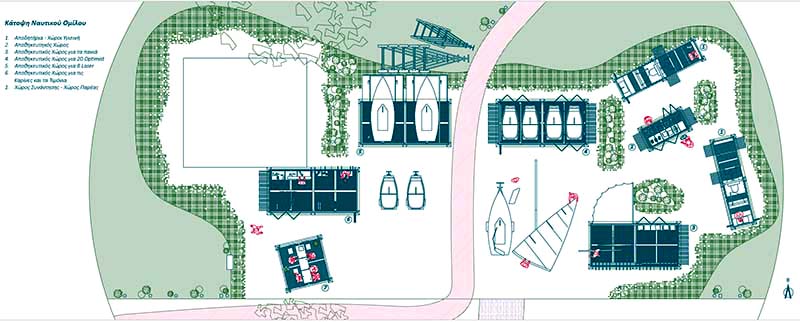







The thesis concerns the redevelopment of the Acro-polis and Siferi area of Skiathos. The thesis aims to improve the accessibility and functionality of the area and providing a small complex of buildings. The small complex of buildings are designed to take on multiple interpretation and changing forms. The small complex will host the islands nautical sailing group.
Supervisor: Micocci Fabiano
Reference Number: 1085
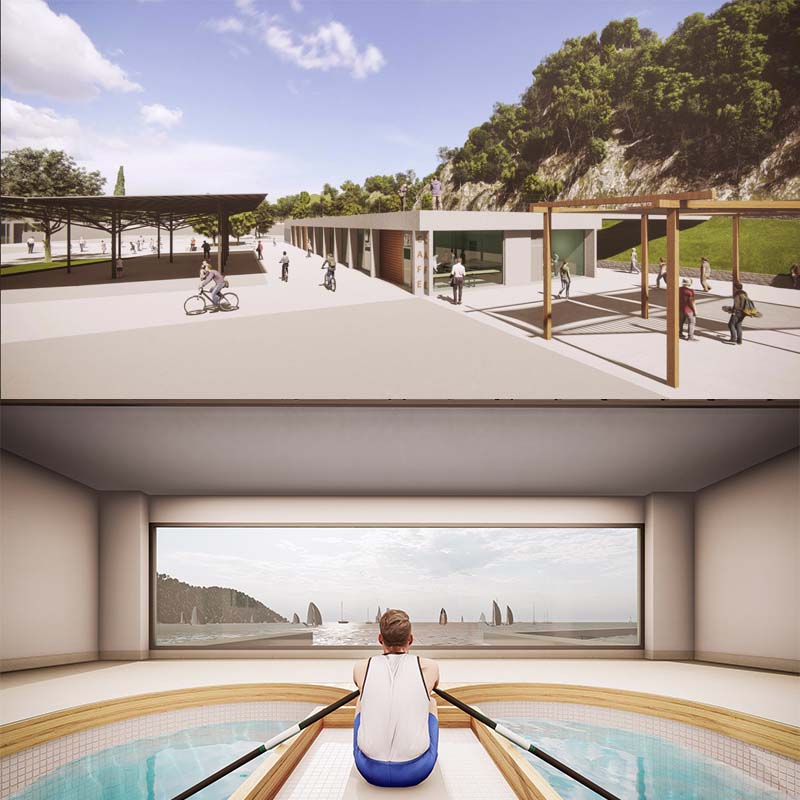











The city of Volos serves as a hub due to its location in relation to the cardinal points (it is located in the center of the country) as well as its geographical character (it combines both mountain and sea), making it an ideal core for the creation of both land and sea sports activities.
This dissertation concerns the redevelopment of the nautical sports club of Volos, N.O.B.A., in the Anavros area, where it is already hosted. The existing building complex of the club is deemed insufficient to meet the needs of the sports of a rowing club. Furthermore, it constitutes an aesthetic downgrade of the area due to the lack of design attention and maintenance of the surrounding environment.
In the design proposal, emphasis is placed on the smooth execution of sports activities in collaboration with the openness of the space to the public, the use of greenery, and the utilization of outdoor space. The final product of this project is an attempt to solve the above design issues with the aim of functional, aesthetic, and urban enhancement of the area.
Supervisor: Paniyiris Costis
Reference Number: 1095

